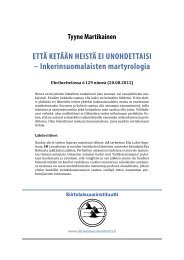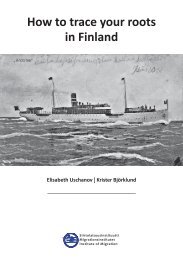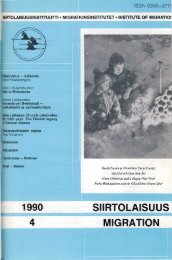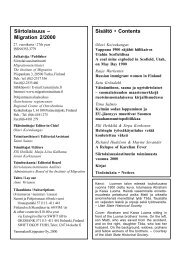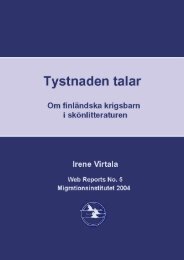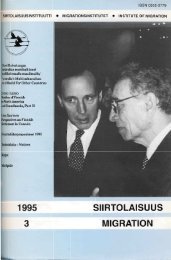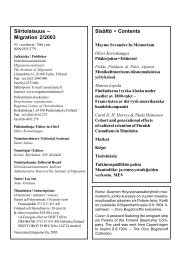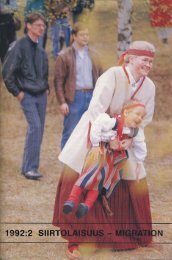1981 - 4 - Siirtolaisuusinstituutti
1981 - 4 - Siirtolaisuusinstituutti
1981 - 4 - Siirtolaisuusinstituutti
You also want an ePaper? Increase the reach of your titles
YUMPU automatically turns print PDFs into web optimized ePapers that Google loves.
oificers being retired on generous terms<br />
taht did much to reconcile them to the new<br />
connection with Russia as well as to avert<br />
a catastrophic effect on the livelihood of a<br />
sizeable part of the upper class. There<br />
were three subsequent phases of military<br />
activity in Finland during the nineteenth<br />
century, from 1812 to 1830. from 1854 to<br />
1868 and from 1881 to 1901, but th€<br />
number of troops raised during these periods<br />
was never large and only the Guards Finnish<br />
Rifle Battalron enjoyed a continuous exisrtence<br />
until its disbandment in 1905. 2 The<br />
very impermanence of the Finnish forces,<br />
their limitation to infantry or rifles {though<br />
there was also a small naval unit for some<br />
years), and their restricted size encouraged<br />
service in the Russian army, by contrast a<br />
vast and stable force, in which career opportunities<br />
were wide and constant and where<br />
the prospecl of active service appealed to a<br />
keen oflicer. The Russian navy, which<br />
sailed far beyond the Baltic and Black Seas,<br />
had its own attraction to the seafaring Finns.<br />
8ut Russian service was attractive, too, even<br />
to the less adventurous members gt the<br />
Finnish upper class. during the first half ol<br />
the nineteenth century because the opportunities<br />
tor suitable occupations in Finland<br />
were so tew. Pressure to obtain civil and<br />
military posts in Finland was reduced by<br />
some members of the upper class entering<br />
the Russian army and navv which had<br />
a large and continuing need for officers.3<br />
The existence in Finland of an oflicer<br />
training school, founded at Haapaniemi<br />
in Savo in 1812 and transferred to Hamina<br />
in 1819 as the Finnish Cadet Corps, resulted<br />
in the production o{ a steady stream ol<br />
Finnish oJficers for whom there was no<br />
employment except in Russian service.4<br />
Before th€ reform of military education in<br />
Russia in the '1860s,<br />
the recruitment of<br />
officers was based, with minor exceptions,<br />
not on education or ability but on birth.<br />
Thus nobles were privileged in being ableto<br />
attend military €drJcational institutions, such<br />
as cadet corps, which gave them the possabi<br />
2<br />
litv of a good start to a military or naval<br />
career. Nobles who entered mtlitary service<br />
as volunteer non{ommissioned officers- the<br />
method by which the maioraty of otficers<br />
was obtained - had to serve for a shorter<br />
time before they were commissioned than<br />
members of other groups which enjoyed the<br />
privilege of entry as volunteers, such as the<br />
sons of clerqy or of merchants.<br />
Although the Russians were happy for Finns<br />
to become otiicers, problems a.ose in fitting<br />
them into the social categories used in Russia.<br />
The principle was established as early as<br />
1820 that Finns stood in the same por,tion<br />
in relation to entry to Russian military<br />
service as the corresponding Russian privileged<br />
estates.5 Although the interprelalion<br />
of this principle caused ditficulties, the sys<br />
tem of entry according to privilege was not<br />
a handicap to the rnajority of Finns who<br />
wanted to become officers since they were<br />
the sons ot officers, or of officials, or<br />
nobles. all categories actually encouraged<br />
by the system to enter militarv service.<br />
To enter Russian service was, ol course, an<br />
action which in many cases was not undertaken<br />
without serious thought. There was at<br />
first reluctance to enter the toreign world<br />
that the Emprre represented. Nevertheless,<br />
by the 1820s, when the first generation<br />
brought up since the beginning of Russian<br />
rule was reaching military age, old antipathies<br />
to Russia as the former enemy of<br />
Sweden and Finland had lessened or vanished,<br />
the Empire s€emed less stranqe and a<br />
greater willrngness to enter the Russian army<br />
was to be expected. By this time, too, the<br />
battalions of the Russian garrison in Finland<br />
were accepted as having clos€ ties with the<br />
country.<br />
The 1830s and 1840s witnessed a number<br />
of measures to encourage Finns to enter the<br />
Russian army and navy. The Finnish Cadet<br />
Corps was enlarged to an establishment of<br />
120 cadets, scholarships for Finns were<br />
;ntroducel at the Bussian Naval Cadet<br />
Corps and at the Pavlovsky Cadet Corps




